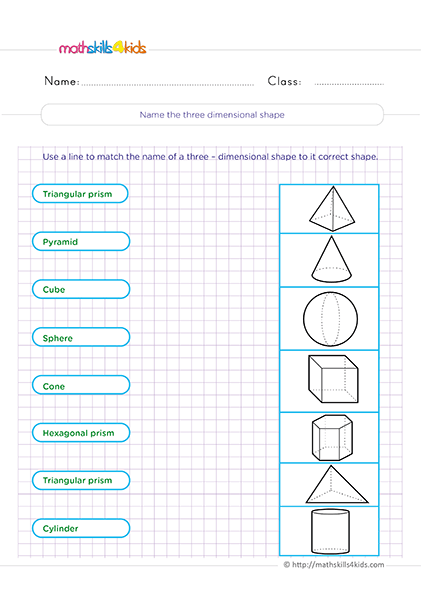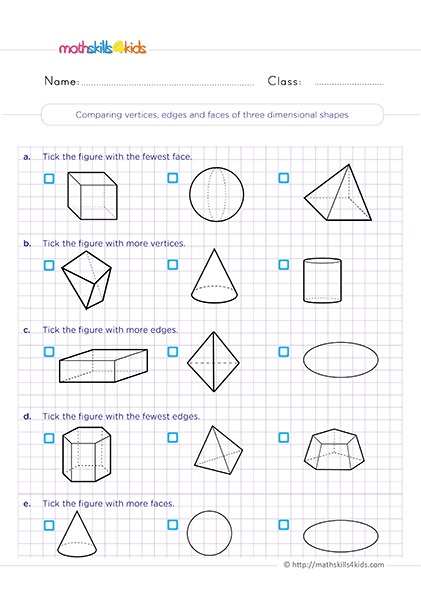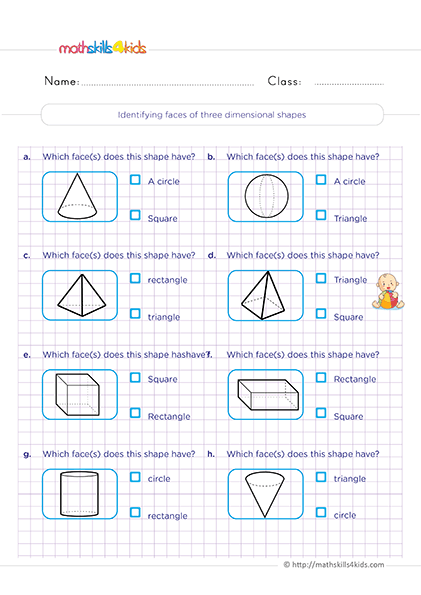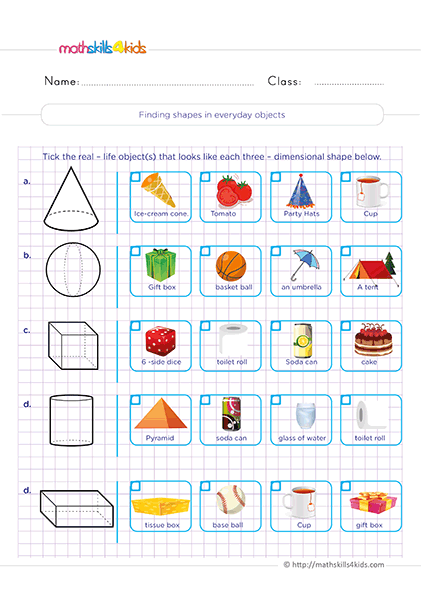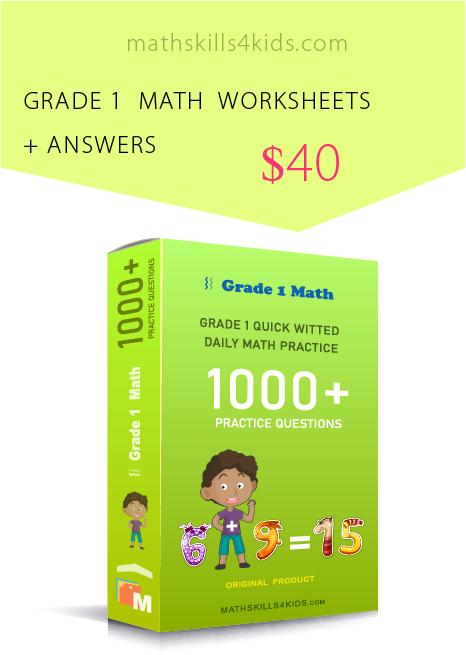Free printable 3D shapes worksheets for Grade 2 math practice
Check out our amazing collection of free printable 3D shapes worksheets for your Grade 2 math practice. These worksheets are designed to help you develop your 2nd grader's spatial reasoning and geometry skills in a fun and engaging way.
-
Also, this article contains amazing resources to help you introduce and reinforce 3D shapes in your math lessons. You'll find:
- An introduction to why 3D shapes matter and how they relate to 2D shapes
- A clear definition and examples of 3D shapes, such as cubes, spheres, cones, cylinders, pyramids, and prisms
- A guide on how to identify 3D shapes from different perspectives and orientations
- Some fun activities with 3D shapes that will challenge your students to sort, build, and solve puzzles
- A set of free printable 3D shapes worksheets for grade 2 math practice that cover various skills and concepts
- A bonus section with more resources to extend your 3D shape learning in Second Grade
Ready to dive in? Let's go!
Why does 3D shapes learning matter for 2nd graders?
Have you been wondering why 3D shapes learning matters for 2nd graders? If not, you've come to the right place.
First, 3D shapes are everywhere in our world. They are the building blocks of objects, structures, and spaces we see and interact with daily. They are also essential for understanding and creating art, design, engineering, and science.
Learning about 3D shapes helps students develop their spatial reasoning skills, which are visualizing and manipulating shapes and objects in three dimensions.
Spatial reasoning is important for many academic subjects, such as geometry, measurement, algebra, physics, and chemistry. It is also a key skill for future careers in STEM fields (science, technology, engineering, and math).
Moreover, learning about 3D shapes helps students connect their math knowledge to the real world. By exploring how 3D shapes relate to 2D shapes, students can deepen their understanding of area, perimeter, volume, surface area, angles, symmetry, and congruence.
By finding 3D shapes in everyday objects, students can apply their math skills to solve problems and make sense of their surroundings.
-
BROWSE THE WEBSITE
-
DOWNLOAD FREE WORKSHEETS
-
-
2nd GRADE MATH TOPICS
- Counting and numbers
- Comparing and ordering
- Reading and writing numbers
- Shape patterns
- Adding of 1-digit numbers
- Subtracting of 1-digit numbers
- Additing 2-digit numbers
- Subtracting within 2-digits
- Up to 3-digit addition
- Subtracting within 3-digit
- Properties of addition & subtaction
- Mixed operations
- Place-value
- Estimating and rounding
- Logical reasoning
- Money Math
- Telling Time
- Data and graphing
- Units of measurement
- 2D shapes
- 3D shapes
- Geometric measurement
- Fractions
- Probability
- Multiplication
- Division
-
-
-
What are 3D Shapes? Definition and Examples
A 3D shape is a shape that has three dimensions: length, width, and height. Unlike flat 2D shapes with only two dimensions (length and width), 3D shapes have thickness and can be viewed from different angles.
Some common examples of 3D shapes you can find in Mathskills4kids.com are:
- Cube: A cube is a shape that has six square faces that are all the same size. A cube has eight vertices (corners) and twelve edges (sides).
- Sphere: A sphere is a shape that has no faces, vertices, or edges. It is perfectly round and has the same distance from its center to any point on its surface.
- Cone: A cone is a shape that has one circular face and one vertex. It narrows from the base to the point.
- Cylinder: A cylinder is a shape that has two circular faces that are parallel and congruent. It has no vertices and two edges that are curved.
- Pyramid: A pyramid is a shape that has one polygonal face (usually a square or a triangle) as the base and triangular faces that meet at one vertex. The number of faces, vertices, and edges depends on the shape of the base.
- Prism: A prism is a shape that has two polygonal faces (usually rectangles or triangles) that are parallel and congruent as the bases and rectangular faces that connect them. The number of faces, vertices, and edges depends on the shape of the bases.
-
How to identify 3D shapes from different perspectives
One of the challenges of learning about 3D shapes is that they can look different depending on how you view them. For example, a cube can look like a square or a hexagon from certain angles. A cylinder can look like a circle or a rectangle from certain angles.
However, our free printable 3D shapes worksheets for Grade 2 math practice have been designed with simple tips and clues to help you easily identify 3D shapes from different perspectives. Tips to pay attention to in shapes include:
- The number of faces you can see
- The shape of the faces you can see
- The number of vertices you can see
- The number of edges you can see
- The orientation of the shape (whether it is upright or tilted)
For example:
- If you see one circular face and a pointy vertex, you are looking at a cone.
- If you see two circular faces and two curved edges, you are looking at a cylinder.
- If you see one square face and four triangular faces that meet at one vertex, you are looking at a square pyramid.
- If you see two triangular and three rectangular faces, you are looking at a triangular prism.
-
Fun activities with 3D Shapes: Sorting, building, and puzzles
Learning about 3D shapes can be fun and hands-on with activities that will engage your students and challenge their thinking. You can use manipulatives like wooden blocks, plastic shapes, or clay to help your students explore and create 3D shapes.
Here are some ideas and fun activities with 3D shapes:
- Sorting: Have your students sort 3D shapes by different attributes, such as the number of faces, the shape of the faces, the number of vertices, or the number of edges. You can also have them sort 3D shapes by whether they can roll, slide, or stack.
- Building: Have your students build 3D shapes using different materials, such as toothpicks and marshmallows, straws and connectors, or paper and tape. You can also have them build models of real-world objects using 3D shapes, such as houses, cars, or animals.
- Puzzles: Have your students solve puzzles that involve 3D shapes, such as tangrams, pattern blocks, or geometric solids. You can also have them make their puzzles by cutting out nets of 3D shapes and folding them into different forms.
-
How to use 3d shapes in real life
One of the best ways to help your students learn about 3D shapes is to show them how they are used in real life. By finding examples of 3D shapes in everyday objects, your students can see the relevance and application of their math skills.
Here are some examples of how to use 3D shapes in real life:
- Art and Design: Many artists and designers use 3D shapes to create sculptures, paintings, drawings, jewelry, furniture, architecture, and more. You can show your students examples of artworks that use 3D shapes or have them create their art projects using 3D shapes.
- Engineering and Science: Many engineers and scientists use 3D shapes to design and build machines, structures, devices, experiments, and more. You can show your students examples of inventions that use 3D shapes or have them design and test their inventions using 3D shapes.
- Games and Sports: Many games and sports use 3D shapes to create equipment, fields, courts, boards, pieces, balls, and more. You can show your students examples of games and sports that use 3D shapes or have them play or invent their games using 3D shapes.
-
Mathskills4kids free printable 3D shapes worksheets for Grade 2 math practice
To help you reinforce your 3D shape learning in second-grade math lessons, we've selected a set of free printable 3D shapes worksheets from Mathskills4kids.com that cover various skills and concepts. These worksheets are perfect for homework, review, assessment, or enrichment.
The worksheets include the following:
- Identifying and naming three-dimensional shapes
- Counting vertices, edges, and faces of 3D shapes
- Identifying faces of 3D shapes
- Finding 3D shapes in everyday objects
Bonus: Find more resources to reinforce 3D shape learning in second Grade here!
If you and your child enjoyed learning about 3D shapes with our free printable 3D shapes worksheets for Grade 2 math practice resource, you might want to check out more resources to help them master this topic.
Here are some of the best ones we found online:
- 3D Shapes Bingo: This is a fun and interactive game that helps kids practice identifying and naming 3D shapes. You can download the bingo cards and the calling cards for free from this website: https://www.twinkl.com/resource/T-N-061-3D-Shape-Bingo.
- 3D Shapes Song: This catchy and educational song teaches kids the names and properties of 3D shapes. You can watch the video and sing along with your child here: https://www.youtube.com/watch?v=2cg-Uc556-Q
- 3D Shapes Flip Book: This creative and hands-on activity lets kids make their flip book of 3D shapes. They can cut out, color, and glue the shapes on each page and then flip through them to see how they look from different angles.
You can get the printable template and instructions from this website: https://www.teacherspayteachers.com/Product/3D-Shapes-Flip-Book-5168160.
- 3D Shapes Scavenger Hunt: This fun and engaging activity challenges kids to find 3D shapes in their environment. They can use a camera or a notebook to record their findings and compare them with their classmates or family members.
You can get the printable scavenger hunt sheet from this website: https://www.mathgeekmama.com/3d-shape-scavenger-hunt/
- 3D Shapes Worksheets: If you want more practice worksheets for your child, you can find a variety of them on this website: https://www.math-salamanders.com/3d-shape-worksheets.html.
They cover topics such as drawing, matching, sorting, and comparing 3D shapes.
Before we conclude, we hope you enjoyed this article on free printable 3D shapes worksheets for grade 2 math practice. We also hope you found it useful and informative.
Thank you for sharing the links of MathSkills4Kids.com with your loved ones. Your choice is greatly appreciated.
-
Learning about 3D shapes is a fun and important part of the second-grade math curriculum. It helps students develop their spatial reasoning skills and connect their math knowledge to the real world.
By visiting Mathskills4kids and using the resources we shared with you in this article, you can help your students master 3D shapes in fun and engaging way.
Thank you for reading, and happy teaching!
